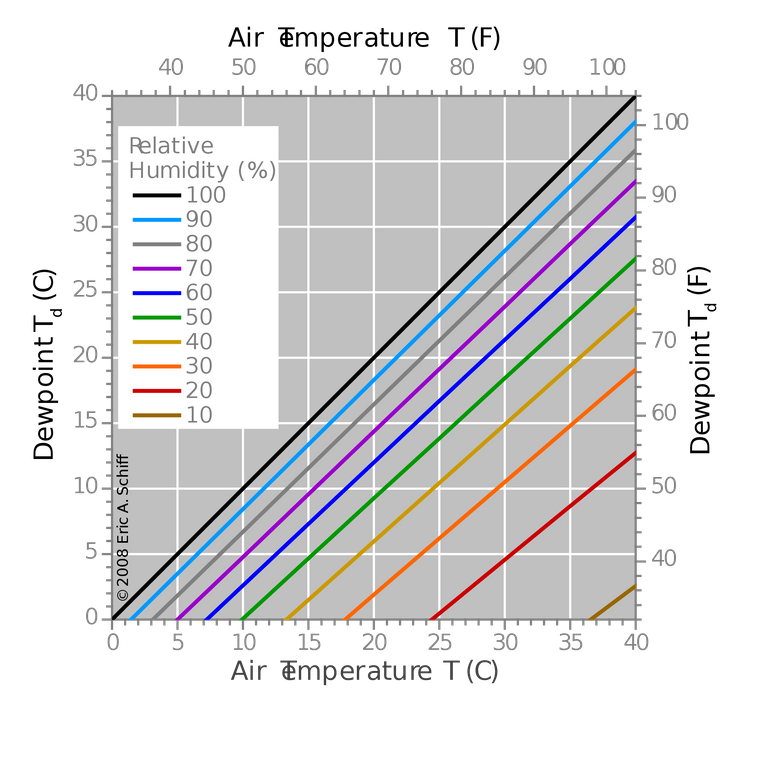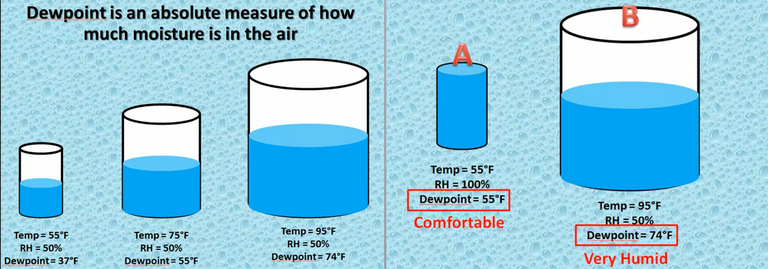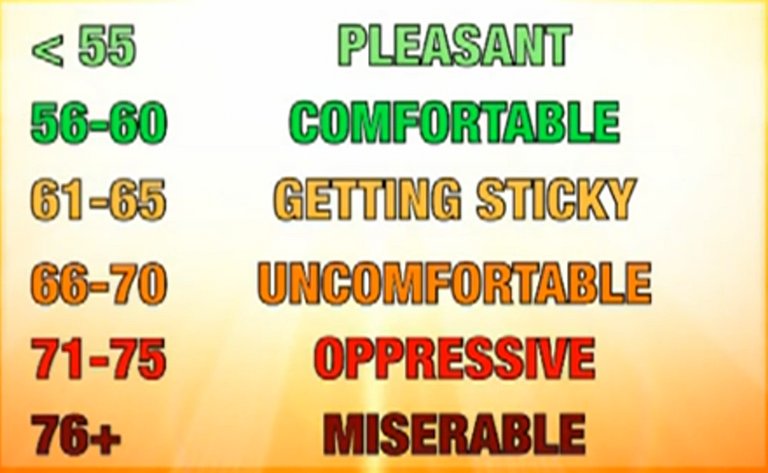image credit
The air around us contains some amount of water vapor. This is what we call “humidity”. As it turns out, there are many misconceptions about air humidity! So how can we measure humidity in the air?
We first need to know that when humid air comes into contact with a cold enough surface, the water vapor from the air will condense (=become liquid) into that surface. The temperature at which water begins to condense is called the “dew point”. This point serves as a point of reference to help us measure humidity, as we will see below.
The “Dew Point”
The dew point is basically the temperature in which air will become saturated with vapor and it will begin to condense to form dew (liquid water). This point depends on how much humidity there is in the air to begin with. A higher dew point indicates more moisture present in the air. This is because only a few water molecules need a much cooler air to condense, while air saturated with water molecules can cause condensation in surfaces only slightly cooler than room temperature air. [Ref. 1, pdf p. 21]
Apart from the amount on water molecules, the dew point also depends on pressure, but at the earth’s surface the pressure varies by only few percent from place to place and in different times. Therefore, with pressure being constant, the dew point is a good indicator of moisture content in the air. [Ref. 2, p. 83]
Relative Humidity
When most people think of humidity, they think of relative humidity rather than the dew point. Relative humidity is given as a percentage, and this is what most weather reports and simple humidity measuring devices show us. However, relative humidity does not express the absolute value of water vapor in the air. Rather, it expresses the amount of water vapor in the air compared to the maximum amount the air can "hold" at that particular air temperature. [Ref. 3, pdf p. 20] It is therefore expressed as a percentage.
To be more precise, “holding” is not exactly a correct term, as the air does not really “hold” moisture in a literal way. The term is used rather for simplification purposes. Meteorologist Steven L. Horstmeyer offers an easy to grasp explanation of how the amount of thermal energy available (temperature) is what leads to different amounts of evaporation in this article. As he explains, the only factors that really determine how much water vapor will be in the air are the availability of water and the amount of thermal energy to do the work of evaporation. You can also find an article with more technical details on
this link.
The Difference Between Relative Humidity and Dew Point
The relative humidity value will change if temperature changes, even if the moisture content of the air stays the same. A higher temperature can “hold”, or keep evaporated, more water in the air, so the relative humidity value will drop with a rise in temperature, even if the amount of water vapor remains unchanged. Relative humidity can change as much as 50% in a day due to a rise in temperature from morning to afternoon. [Ref. 4, p. 83]
On the other hand, the “dew point” does not change with temperature but only with the amount of moisture in the air. It is therefore an absolute indicator for the amount of water vapor in the air. If you know the dew point of the air and the temperature of a surface, you can predict whether the moisture will condense on said surface.
Dew point can be found by inputting temperature and relative humidity. The three are related according to the following graph:
image credit
If the air is cooled but the moisture content remains constant, the relative humidity will rise until it reaches 100%. In this temperature the moisture content becomes saturated. This is the same thing as the “dew point”. If the air is cooled further than that, for example near cooler surfaces, some of the moisture will condense. [Ref. 5] In such conditions, we often observe fog or mist forming.

This youtube video offers a great explanation of the differences between these two measurements using the analogy of containers. A higher temperature is like a large container, with capacity for a large volume of water. If half of this container is full, it is the equivalent to a 50% relative humidity. A lower temperature is like a small container. If this small container is also half full, then it is also equivalent to a 50% relative humidity, even if the absolute amount of water in the first container is much more than in the second!
screenshot credit
So what determines the way we feel about temperature and humidity?
Relative humidity is not a good measure of how humid it is, or feels, outside. A more accurate representation of the human discomfort level is the dew point. A relative humidity of 70% could feel comfortable at a 20°C temperature but would cause discomfort at 30°C, because it signifies a higher dew point. You can find a tool to calculate dew point by imputing temperature and relative humidity here.
Below is a picture that determines the level of discomfort people experience in different dew points (°F):
screenshot credit
In the next post, I will answer more clarifying questions about extreme dew points, fog formation and the usefulness of measuring relative humidity. Thank you for reading and if you have any questions, add a comment and I will try to answer them in the next post!




Cool, I now know what air humidity means on weather forecast. I actually never asked that question to myself :)
It was a long time I didn't read anything from you. Glad to see you are still around us :)
I'm glad it helped! I actually come from a quite humid country and it really bugged me that my perception did not match the weather report :) It turns out the subject of humidity and water behavior is a very interesting one especially when looking for adequate building materials and the proper air conditioning systems for places with different humidity and temperatures.
Yes I'm still here, trying to be a bit more involved :)
One good way is to join us on discord (dunno whether you are already around there). Feel free to pass by and say hi! :)
I am already on the discord channel, thanks for the invitation! :)
I didn't notice. Sorry, I should have checked before asking :p